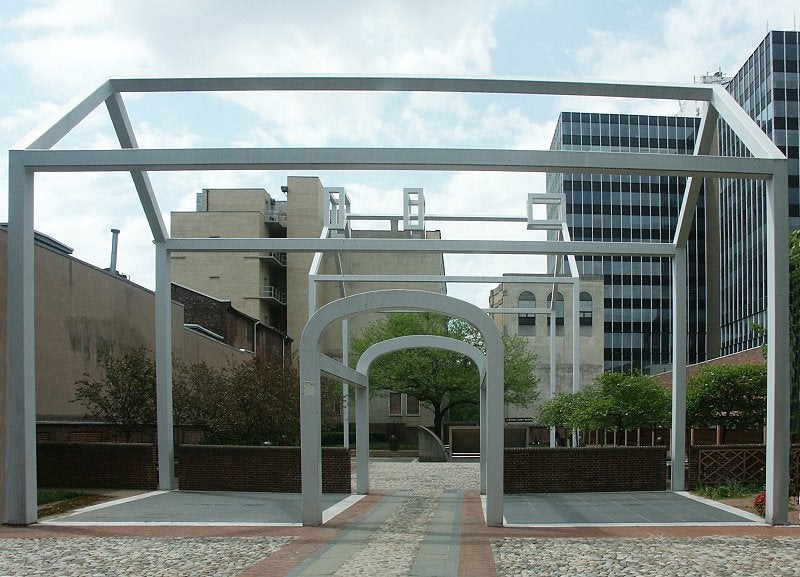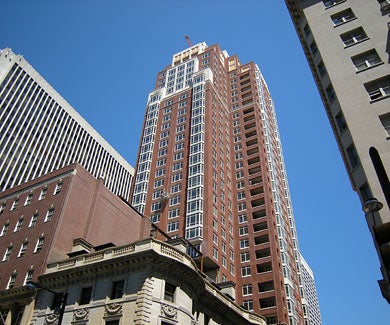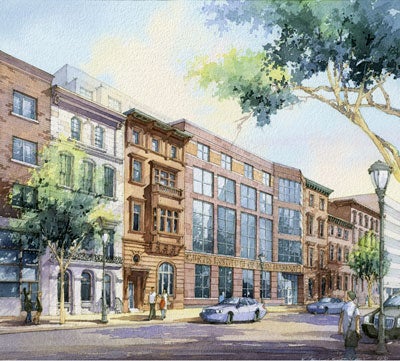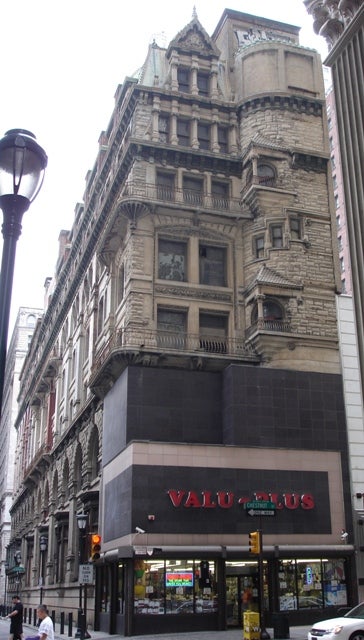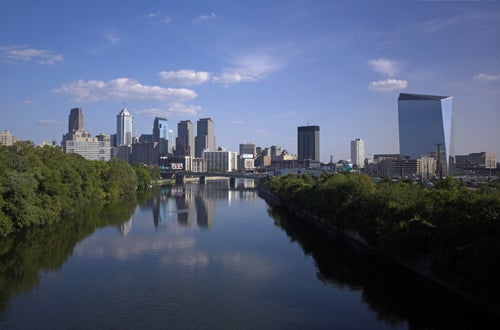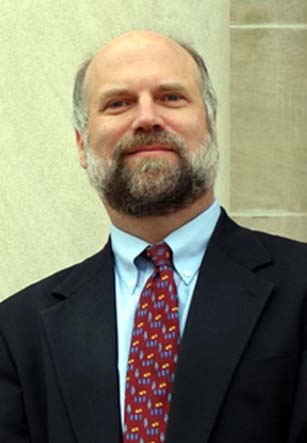Making a built statement or just filling in
March 8, 2010
By JoAnn Greco
For PlanPhilly
In Philadelphia, the uneasy alliance between new and old buildings occasionally flares into combat. The resulting skirmish, says architect and historian Steven Semes, almost always sacrifices cohesiveness to individuality. Whether this occurs via a modern addition glommed onto a historic building, or through the insertion of a modern building into a traditional streetscape, dissonance ensues.
Looking around town, we see evidence of the ways in which this happens.
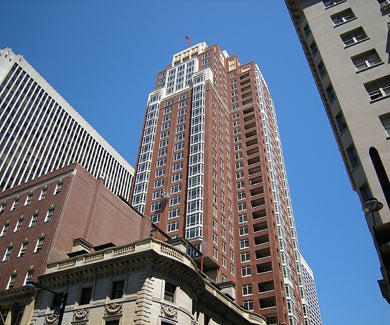
The new Robert A.M. Stern skyscraper, 10 Rittenhouse, for example, attempts to borrow elements from its older neighbor, but soon goes its own way to a quite obvious (and soaring) departure. Placed on a tight, though vibrant, side street off of Rittenhouse Square, the building’s height clearly individualizes it from its neighbor. In the end, it doesn’t make much of an attempt to fit in.
The idea of homage reaches ironic abstraction in Robert Venturi’s and John Rauch’s “Ghost Structure,” which playfully takes the form of the kind of building that Ben Franklin might have lived in, and then reduces it to a mere sketch. “Venturi is a great mind, but I think this is a joke,” Semes told PlanPhilly in an interview prior to his lecture March 9 at The Athenaeum.
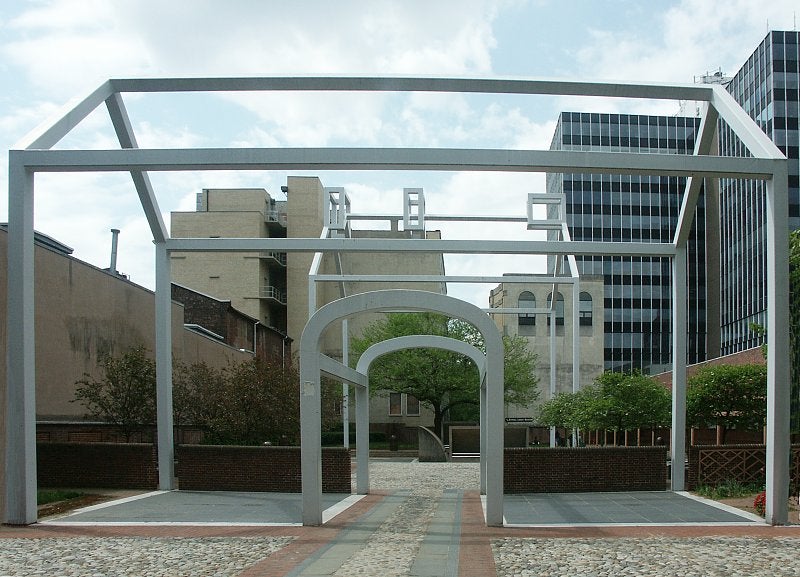
“We learn nothing from this frame, and we would have if the building was totally reconstructed.”
The violent ‘facadectomy’, like the one currently in progress on the 1600 block of Locust St., as Curtis Institute of Music readies itself for an expansion, also gives a nodding glance to the idea of incorporating the old. But, says Semes, ultimately what goes on beyond and behind such a facade contains no reference to that past.
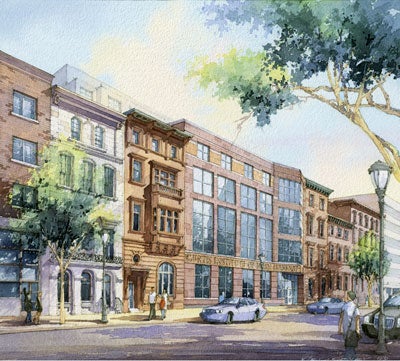
“What’s happened to the landmark? It’s as if the intent is to grudgingly save it while pretty much cutting it off,” Semes says.
And then there’s the real slap in the face — bracing to many, reason for a duel to others — of projects like the one now under consideration for the Keystone National Bank building. That “intervention,” while promising to restore much of the building to its former glory, stops short of a total re-creation. Instead, it proposes erecting a new glass entryway to replace the horrid storefront slapped on in the ’60s.

Thirty years from now, will this new entrance look dated, garish, misguided? Probably.
None of these approaches can ever truly succeed, believes Semes, because the differences between classic and contemporary architecture are “fundamentally irreconcilable,” he writes in his new book, The Future of the Past (W.W. Norton).
“There are ways to make something modern,” he told PlanPhilly. “But what I’m questioning is the idea that you have to compose something that’s deliberately jarring. What we should be thinking of instead is: ‘how do we work within the historic setting?'”
In his advocacy of what he calls the “appropriate,” his pursuit of the intact “ensemble,” and his call for the avoidance of the “incongruous,” Semes urges us to consider contexts. “The idea that the building exists as a kind of entity takes an extremely narrow view of what the building means,” he says.
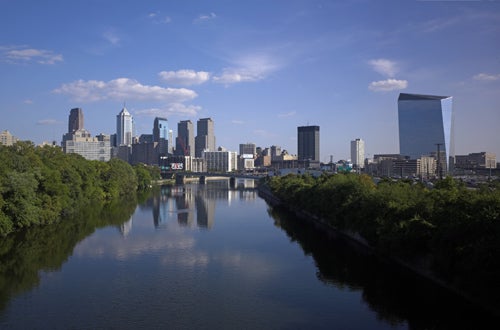
“The Cira Centre, for example, would be a lovely object if it was three-inches tall and sitting on a tabletop like some sort of Swarovski candlestick,” he continues. “Unfortunately, it’s a 30-story office building that looms over everything in a very menacing way. If you think that your job is to fit seamlessly into the context, you’ll have one result. If your primary object is to make sure the first thing that’s noticed is your project, then you’ll get a different result.”
Traditional cities are ones whose buildings contribute to the whole, Semes elaborates, whereas contemporary downtowns are more like zoos. “There’s the Gehry here, the Hadid there, the Nouvel over there,” he says. “And they all have to be kept apart — they have nothing to do with each other.”
Borrowing one idea from the zoo, and national parks and public gardens and the like, though, might make a good idea, Semes suggests. That’s the notion of “conservation,’ a central theme of his book. “If you have a wetland or a battleground, you don’t interfere with it,” he says. “You try to cultivate it and keep the ecosystem alive and intact. There’s an ideal of healing and caring for a historic setting that makes a lot of sense.”
Just as we wouldn’t tolerate a big box store being introduced into such a setting, we should think more carefully about affixing jarring interventions to old buildings — like the glass “gaskets” that are used so prominently these days to link old sections with new additions — and about incorporating modern buildings into historic streetscapes, Semes says.
“While there ought always to be room in our cities for architectural innovation and experimentation, there must also be places dedicated to the continuity of valued architectural character,” he writes. “Keeping these two desiderata in balance is the challenge now faced by architects and preservationists alike.”
Of course, there is a tactic that makes the challenge easier: total reconstruction. It’s the Graff House (where Thomas Jefferson lived as he drafted the Declaration of Independence) vs. the Ghost Structure. “There’s no question that some people find the act of reconstruction a diminishing of the surrounding historic structures,” Semes says. “But if you look at that argument closely, it begins to unravel. The history of architecture is filled with buildings that are copies. The Parthenon is a copy, as is almost all of the Louvre that we see today, and temples in Japan.
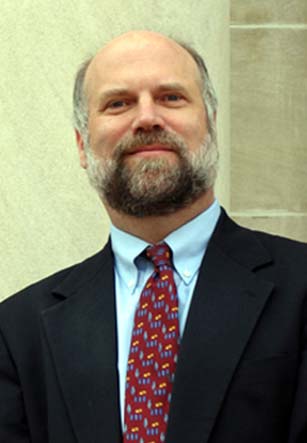
Steven Semes
“These tell us that what’s important isn’t the building itself,” he continues. “What’s important — assuming the re-creation is meticulous — is a sense of the ongoing culture.” In his book, Semes singles out Philly’s controversial Richardson Dilworth House, as a prime example. The 1957 building, while not a reconstruction, “contributes to the beauty and coherence of the Society Hill Historic District,” he writes. “[Yet] it was seen as having little or no architectural value because its late Colonial Revival style ran counter to the authorized narrative of Philadelphia’s architectural history.”
In other words, the house doesn’t jive with our notions of mid-20th-century architecture, so we don’t value it. But even though the Dilworth House isn’t “authentic,” it is “appropriate” because it fits into its greater surroundings, giving precedence to the idea of the ensemble, Semes argues.
As we look around at Philadelphia — old new, and about-to-come — the takeaway is clear. “Cities are living organisms,” Semes says, “and so of course not everything has to be traditional. But I think that having pre-conceived notions of contemporary architecture — whether it’s as a glass box or as a blob molded from some new material — isn’t the right approach, either. If the architecture of our time is whatever Renzo Piano or Steven Holl says it is, I don’t see that the rest of us are obligated to go along.”
Contact JoAnn Greco, ASJA, SATW, at www.joanngreco.com
Check out her new online magazine, TheCityTraveler at www.thecitytraveler.com
WHYY is your source for fact-based, in-depth journalism and information. As a nonprofit organization, we rely on financial support from readers like you. Please give today.



